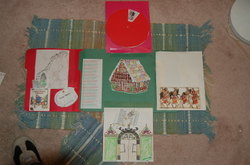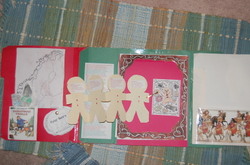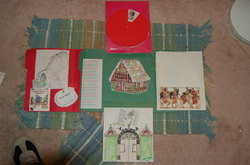Story
The Gingerbread Baby by Jan Brett
Supplemental Stories
Musabi Man:
Hawaii
’s Gingerbread Man
The Gingerbread Man Jim Aylesworth
The Gingerbread Doll by Susan Tews
Read Alone: “Hansel and Gretel” and other stories by the Brothers Grimm
Social Studies
Compare the Hawaiian version of the story to Jan Brett’s story.
Narration with innovation (for the lapbook): Make a Venn diagram of the comparison.
Language Arts
This is a great book to use to reinforce a sense of story and story structure.
v This book is a circle story, so we can present it to the children with the circle drawn and divided into twelve parts. Prepare pictures representing each part. As you read the story, paste the picture into a section of the circle, working your way around until you return to the first segment which was the picture of Matti's home. I laminated the finished wheel and then I placed another cardstock circle with just one wedge cut from it over the top and secured with a brad. Now, the circle can be turned to show each segment in turn as the child re-tells the story. You can see the wheel on the upper flap.

Narration with innovation (how to make the circle for a lapbook): Make an 8 inch medium weight cardstock circle. Divide into have twelve sections:
1) The house from the title page (that's where the story begins and ends)--2 1/2 X 3 1/4 inch reduction on the copier trimmed to fit the wedge
2) Gingerbread boy in the bowl .2 1/2 X 3 1/4 inch reduction on the copier trimmed to fit the wedge.
3) mother and father searching --copier reduction again
4) Cat--I printed this page as is and just trimmmed the figures
5)Dog--as the cat
6)goat--as the cat
7) girls with braids knotted--copier reduction
8) fox--as the cat
9) milk man--copier reduction
10) pig--as the cat
11) river scene --copier reduction
12) Matti with the gingerbread house --copier reduction
All my children enjoyed the circle story lesson. For the older ones, I encouraged them to write a detailed narration of the Gingerbread Baby, bearing in mind the structure of a circle story. The protagonist begins at home, goes on an adventure and then returns home.
v Discuss the structure of the story using the terms conflict, rising action, climax, and denouement.
Be certain the child understands each term and can identify the part of the story.
Narration with innovation (for the lapbook): Gingerbread doll fold:

Accordian fold a piece of paper four times and cut into a gingerbread shape. There is a pattern at this site:
Decorate the cover of the folded book to look like the gingerbread baby. Opening it out, on the first fold, write “conflict,” then on the next one “Rising Action,” then, “Climax” and then “Denouement.” The children will identify and dictate each part. You can record these on the bodies of your folded dolls if you type and fiddle with the font.
v Look closely at the parallel story unfolding in the insets in the margin and discuss parallel construction.
Poetry and copywork:
Run, run, as fast as you can!
You can’t catch me, I’m the Gingerbread Man!
Once there was a gingerbread man,
Baking in a gingerbread pan.
Raisin eyes and a cherry nose,
Trimmed right down to his fingers and toes.
A gingerbread man in a gingerbread pan!
Here's the old woman who made him so sweet,
A treat for her and her husband to eat,
She made him with flour and sugar and eggs,
She gave him a face and two arms and two legs.
A gingerbread man in a gingerbread pan
Now open the oven to see if he's done,
This gingerbread man, he know how to run.
Out of the oven and onto the floor,
Now run away out the kitchen door.
The gingerbread man, he's out of the pan!
Now chase him old woman, now chase him old man
Chase him, yes chase him as fast as you can!
Through the garden and out the gate,
Catch him right now, before it's too late.
The gingerbread man, he's out of the pan!
Along came a cow who wanted a treat
And the gingerbread man, he looked good to eat
Run, run, as fast as you can
You can't catch me, I'm the gingerbread man
I'm the gingerbread man and I'm out of the pan!
Along came a horse who wanted a snack
But the gingerbread man, he never looked back
Run, run, as fast as you can
You can't catch me, I'm the gingerbread man
I'm the gingerbread man and I'm out of the pan!
Along came a farmer who wanted a treat
And the gingerbread man, he looked good to eat
Run, run, as fast as you can
You can't catch me, I'm the gingerbread man
I'm the gingerbread man and I'm out of the pan!
Along came a dog who wanted a snack
But the gingerbread man, he never looked back
Run, run, as fast as you can
You can't catch me, I'm the gingerbread man
I'm the gingerbread man and I'm out of the pan!
Along came a hog who wanted a treat
And the gingerbread man, he looked good to eat
Run, run, as fast as you can
You can't catch me, I'm the gingerbread man
I'm the gingerbread man and I'm out of the pan!
Along came a fox who wanted a treat,
And this gingerbread man, he looked good to eat.
Jump on my back, my gingerbread pet,
And we'll cross the river, so you won't get wet
Mr. Gingerbread man, who's out of the pan!
There was no place to go, there was no place to run
And a ride on the river could be lots of fun!
So off with the fox did Gingerbread go
And what happened next, you already know
To the gingerbread man, who's out of the pan
That sly old fox had a de-lic-ious treat
And the old man and woman had nothing to eat
Not a bite was left for the cow or the dog,
The horse or the farmer or hungry old hog
There's no gingerbread man in or out of the pan!
So let us go home and get out the pan
And we'll make ourselves a new gingerbread man!
And when he is eaten, we'll make us some more
But this time we'll be certain to lock the back door!
A new gingerbread man, in a gingerbread pan!
Art/Cooking
v Watch the video online of Jan Brett drawing and reading The Gingerbread Baby
v Mix and bake and decorate gingerbread baby cookies.
v Make gingerbread houses; kits are fine.
v Sequence the steps in making the house.
v Narration with innovation (for the lapbook) Gingerbread flap book:
At the Jan Brett site is an interactive activity where the children can decorate their own gingerbread houses. Each child did this activity and I printed the finished product at 75%. This became the cover of the book, seen pictured in the middle of the lapbook.
We built our gingerbread house from a kit. I save the picture directions, copied them for each child and cut them apart. On the next page of the book, a green piece of paper, cut to the shape of the house, the child glued the steps to making the house in order.
The final page is another shaped green paper with a photo of the child building his house.

Stay tuned for plans for more Jan Brett Christmas books and a link to Kim's Jan Brett Lapbooks.

















